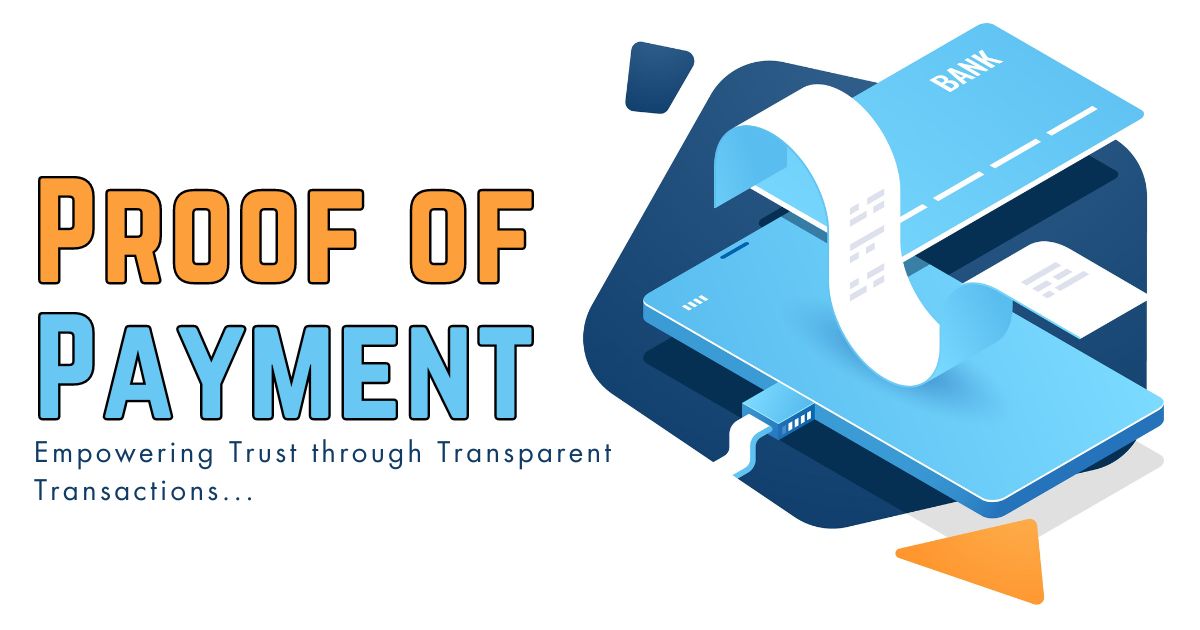
| March 28th, 2024 |
The Importance of Proof of Payment — A Comprehensive Guide!
According to the worlds of finance and commerce, evidence of payment plays a crucial role in ensuring accountability, transparency, and reliability in transactions. In any type of transaction, be it an online buy, a complicated commercial arrangement, or a straightforward cash purchase, both sides must have solid proof of payment. We’ll explore the unique characteristics of proof of payment, its importance in many industries, and how it promotes trustworthiness and security in financial transactions in this extensive explanation.
Understanding Proof of Payment —
Any documentation or additional proof that confirms a funds transfer has taken place between two parties is referred to as proof of payment. It acts as a record of the money paid by a customer to a merchant in return for products or services. These documents may be in the form of invoices, bank statements, payment confirmations, receipts, or electronic copies.
Importance of Proof of Payment —
1. Legal Protection:
In the event that there are disagreements or legal problems between parties, proof of payment is essential evidence. Having recorded proof of payment on hand can help settle disputes about conditions of a transaction or the delivery of products or services in a quick, and correct way.
2. Financial Records:
For the purposes of taxation, auditing, and financial planning, businesses must keep reliable financial records. A clear record of financial transactions is provided by proof of payment, which makes bookkeeping easier and ensures regulatory compliance.
3. Accountability and Trust:
In both personal and professional transactions, proof of payment fosters accountability and trust between parties. It establishes a sense of reliability and reassures both buyers and sellers that the transaction has been completed satisfactorily.
4. Fraud Prevention:
Having verifiable proof of payment can help mitigate fraudulent activities such as identity theft, unauthorized transactions, or chargebacks. It enables businesses to detect and prevent fraudulent behavior, protecting their financial interests and reputation.
5. Financial Planning:
For individuals, maintaining records of payments made for goods and services is essential for budgeting and financial planning. Proof of payment helps track expenses, identify spending patterns, and make informed decisions about future purchases.
Types of Proof of Payment —
1. Receipts:
A written statement that confirms the completion of a transaction and includes information like the date, the amount paid, a description of the products or services, and the mode of payment is called a receipt. For the buyer and seller, it acts as solid evidence of the transaction.
2. Invoices:
An invoice is a formal request for payment that a merchant sends to a buyer. It includes information on the goods or services that were delivered, the terms and instructions for payment that have been agreed upon. It functions as a legal document that specifies the terms of the transaction and establishes the obligation to pay.
3. Bank Statements:
A bank account’s whole history of transactions, including deposits, withdrawals, transfers, and payments, is kept on track in bank statements. They function as formal records of financial transactions and can be presented in a variety of ways as evidence of payment.
4. Payment Confirmations:
Payment confirmations are notifications or emails sent by payment processors or financial institutions to confirm the successful completion of a transaction. They typically include details such as the transaction amount, date, recipient, and confirmation number, providing reassurance to both parties.
Best Practices for Maintaining Proof of Payment —
1. Keep Records Organized:
Maintain a systematic approach to organizing and storing proof of payment documents, whether in physical or digital format. This ensures easy access to documentation when needed and reduces the risk of loss or misplacement.
2. Verify Accuracy:
Review proof of payment documents for accuracy and completeness, ensuring that all relevant details are correctly recorded. Address any discrepancies or errors promptly to maintain the integrity of financial records.
3. Retain Documentation:
Retain proof of payment documentation for an appropriate period, as required by legal or regulatory requirements. Proper record retention helps protect against disputes, audits, or inquiries that may arise in the future.
4. Secure Information:
Protect sensitive financial information contained in proof of payment documents from unauthorized access or disclosure. Implement security measures such as encryption, password protection, or secure storage to safeguard sensitive data.
5. Backup Regularly:
Backup digital proof of payment records regularly to prevent loss due to system failures, data corruption, or cyber threats. Utilize secure cloud storage or external storage devices for redundant backups to ensure data resilience.
Conclusion —
In overall, proof of payment is essential for confirming financial transactions and promoting transparency and trust across a range of businesses. Having physical proof of payment is crucial for both parties, whether it’s an elaborate invoice for a commercial transaction or a straightforward receipt for a retail purchase. Through the adoption of best practices for documentation management and the maintenance of correct proof of payment records, people and organizations can reduce risks, optimize financial procedures, and create closer bonds with their stakeholders.
